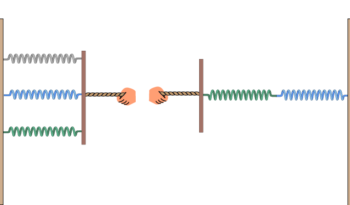Here is an example of the application of Newton’s second law of motion to a ballistic problem. The problem we want to consider is calculating the critical angle \(\theta_c\) of firing a projectile from the ground toward a high place (of height \(h\)), located at a distance \(L\) in front of the place of firing, in order to reach the maximum horizontal distance \(z_{\text{max}}\) on the high place. It is supposed that air resistance is negligible and that the initial velocity \(v_0\) is a known value. The problem is easy to solve however nontrivial in the sense that there could be no solution. Then, part of the problem is to find the admissible values of the parameters \(L\), \(h\), and \(v_0\) such that a solution exists.
Let’s start by recalling the equations of motion in two dimensions:
\begin{equation}
\begin{split}
m\frac{d^2x}{dt^2}&=0\\
m\frac{d^2y}{dt^2}&=-mg ,\\
\end{split}
\end{equation}
whose respective solutions are
\begin{split}
x(t)&=x_0+(v_0\cos\theta)t\\
y(t)&=y_0+(v_0\sin\theta)t-\frac{1}{2}gt^2
\end{split}
\end{equation}
In the present case it is convenient to select the origin of coordinates at the place of firing so that \((x_0,y_0)=(0,0)\). Then, we can put \(t=x/(v_0\cos\theta)\) on the equation for \(y\) to get the following relation between the coordinates:
y=(\tan\theta)x-\frac{g}{2v_0^2\cos^2\theta}x^2.
\end{equation}
Equation (3) is the starting point to solve the problem.
Maximum horizontal reach on the high terrain
When the projectile reaches the high terrain, the \(y\) coordinate takes the value \(h\), and the coordinate \(x\) takes the value \(L+z\). So, equation (3) becomes
h=(\tan\theta)(L+z)-\frac{g}{2v_0^2\cos^2\theta}(L+z)^2.
\end{equation}
We are looking for the angle \(\theta_c\) such that \(z\) reaches its maximum possible value. This means that \(\theta_c\) is determined by the condition \(dz/d\theta=0\). Implicit differentiation of equation (4) leads to
\begin{split}
&\left(\frac{1}{\cos^2\theta}\right) (L+z)+(\tan\theta)\frac{dz}{d\theta}\\
&-\frac{g\sin\theta}{v_0^2\cos^3\theta}(L+z)^2-\frac{g}{2v_0^2\cos^2\theta}\frac{dz}{d\theta}=0.
\end{split}
\end{equation}
Now we apply the condition \(dz/d\theta=0\) when \(\theta=\theta_c\):
\left(\frac{1}{\cos^2\theta_c}\right)(L+z_{\text{max}})-\frac{g\sin\theta_c}{v_0^2\cos^3\theta_c}(L+z_{\text{max}})^2=0.
\end{equation}
From equation (6) we obtain the relation
\begin{equation}
L+z_{\text{max}}=\frac{v_0^2}{g\tan\theta_c}.
\end{equation}
Now we plug that expression in equation (4):
h=\frac{v_0^2}{g}-\frac{v_0^2}{2g\tan^2\theta_c\cos^2\theta_c}
\end{equation}
The latter equation is readily solved to get
\boxed{\sin\theta_c=\frac{1}{\sqrt{2(1-gh/v_0^2)}}}.
\end{equation}
The latter equation imposes a restriction on the possible values the parameters \(h\) and \(v_0\) can take, namely \(\frac{2gh}{v_0^2}\leq1\). Other wise, the critical angle is not defined (remember that \(\sin\theta\leq1\)).
The maximum horizontal reach is obtained by plugin the latter result in equation (7) and using the relation \(\cos\theta=\sqrt{1-\sin^2\theta}\). The result is
\boxed{z_{\text{max}}=\frac{v_0^2}{g}\sqrt{1-2gh/v_0^2}-L}
\end{equation}
The latter equation imposes an additional restriction on the possible values of the parameters. Indeed, the condition \(z_{\text{max}}\geq0\), together with \(\frac{2gh}{v_0^2}\leq1\) and equation (10) implies
\begin{equation}
\boxed{\frac{2gh}{v_0^2}+\left(\frac{gL}{v_0^2}\right)^2\leq 1}
\end{equation}
Let’s interpret the last result. If \(L=0\), then the projectile can be fired vertically upward only. Its kinetic energy \(mv_0^2/2\) allows it to reach a maximum height given by conservation of energy. i.e., \(mv_0^2/2=mgh\). In this case, it is clear that the horizontal reach on the high terrain is zero. On the other side, if \(h=0\), then the land is flat and the maximum admissible value for \(L\) is just the maximum horizontal reach \(v_0^2/g\).
In addition, any possible combination of \(L\), \(h\), and \(v_0\) that makes the left side of equation (11) exactly equal to one, corresponds to the case when the projectile just reaches the high place, and the horizontal distance on it is zero.
Any other combination of the parameters that fulfill the strict inequality in equation (11) corresponds to \(z_{\text{max}}>0\). Finally, any combination of the parameters that make the left side of equation (11) greater than one, corresponds to cases where it is impossible to reach the high terrain.


Leave a comment